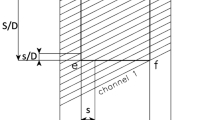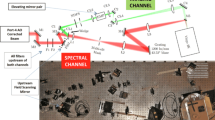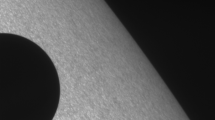Abstract
For high resolution spectral observations of the Sun – particularly its chromosphere, we have developed a dual-band echelle spectrograph named Fast Imaging Solar Spectrograph (FISS), and installed it in a vertical optical table in the Coudé Lab of the 1.6 meter New Solar Telescope at Big Bear Solar Observatory. This instrument can cover any part of the visible and near-infrared spectrum, but it usually records the Hα band and the Ca ii 8542 Å band simultaneously using two CCD cameras, producing data well suited for the study of the structure and dynamics of the chromosphere and filaments/prominences. The instrument does imaging of high quality using a fast scan of the slit across the field of view with the aid of adaptive optics. We describe its design, specifics, and performance as well as data processing












Similar content being viewed by others
References
Ahn, K.: 2010, Development of New Astronomical Instruments for High Resolution Solar Observations. Ph.D. thesis, Seoul National University.
Ahn, K., Chae, J., Park, H.-M., Nah, J., Park, Y.-D., Jang, B.-H., Moon, Y.-J.: 2008, J. Korean Astron. Soc. 41, 39.
Beckers, J.M.: 1964, A Study of the Fine Structures in the Solar Chromosphere. Ph.D. thesis, Utrecht University.
Cao, W., Gorceix, N., Coulter, R., Ahn, K., Rimmele, T.R., Goode, P.R.: 2010, Astron. Nachr. 331, 636.
Cavallini, F.: 2006, Solar Phys. 236, 415.
Chae, J.: 2004, Solar Phys. 221, 1.
Chae, J., Park, Y.-D., Park, H.-M.: 2006, Solar Phys. 234, 115.
de Pontieu, B., McIntosh, S., Hansteen, V.H., Carlsson, M., Schrijver, C.J., Tarbell, I.M., et al.: 2007, Publ. Astron. Soc. Japan 59, 655.
Goode, P.R., Denker, C.J., Didkovsky, L.I., Kuhn, J.R., Wang, H.: 2003, J. Korean Astron. Soc. 36, S125.
Goode, P.R., Coulter, R., Gorceix, N., Yurchyshyn, V., Cao, W.: 2010, Astron. Nachr. 331, 620.
Hanaoka, Y.: 2003, In: Keil, S.L., Avakyan, S.V. (eds.) Innovative Telescopes and Instrumentation for Solar Astrophysics, Proc. SPIE 4853, 584.
Judge, P.: 2006, In: Leibacher, J., Stein, R.F., Uitenbroek, H. (eds.) Solar MHD Theory and Observations: A High Spatial Resolution Perspective, ASP Conf. Ser. 354, 259.
Langangen, Ø., De Pontieu, B., Carlsson, M., Hansteen, V.H., Cauzzi, G., Reardon, K.: 2008, Astrophys. J. 679, L167.
Nah, J.-K., Chae, J.-C., Park, Y.-D., Park, H.-M., Jang, B.-H., Ahn, K.-S.: et al.: 2011, Publ. Korean Astron. Soc. 26, 45.
Park, H.: 2011, Development of Fast Imaging Solar Spectrograph and Observation of the Solar Chromosphere. Ph.D. thesis, Chungnam National University.
Reardon, K.P., Uitenbroek, H., Cauzzi, G.: 2009, Astron. Astrophys. 500, 1239.
Rees, D.E., López Aristle, A., Thatcher, J., Semel, M.: 2000, Astron. Astrophys. 355, 759.
Rutten, R.: 2006, In: Leibacher, J., Stein, R.F., Uitenbroek, H. (eds.) Solar MHD Theory and Observations: A High Spatial Resolution Perspective, ASP Conf. Ser. 354, 276.
Schroeder, D.J.: 2000, Astronomical Optics, 2nd edn., Academic Press, San Diego.
Shibata, K., Nakamura, T., Matsumoto, T., Otsuji, K., Okamoto, T.J., Nishizuka, N., et al.: 2007, Science 318, 1591.
Stolpe, F., Kneer, F.: 1998, Astron. Astrophys. Suppl. 131, 181.
Tziotziou, K.: 2007, In: Heinzel, P., Dorotovič, I., Rutten, R.J. (eds.) The Physics of Chromospheric Plasmas, ASP Conf. Ser. 368, 217.
Wallace, L., Hinkle, K., Livingston, W.: 2007, An Atlas of the Spectrum of the Solar Photosphere from 13,500 to 33,980 cm −1 (2942 to 7 405 Å). National Solar Observatory.
Acknowledgements
We are grateful to the referee for a number of constructive comments. This work was supported by the National Research Foundation of Korea (KRF-2008-220-C00022) and by the Development of Korean Space Weather Center, a project of KASI.
Author information
Authors and Affiliations
Corresponding author
Additional information
Initial Results from FISS
Guest Editor: Jongchul Chae
Appendices
Appendix A: Flat Fielding
Let us denote the index of a pixel along the wavelength direction by i and that along the slit direction, by j. An averaged spectrogram, s ij should depend on i only, but not on j if the spatial average is ideally done so that we may write s ij =o i where o i is the one-dimensional spectrum of the average sun. Then the kth spectrogram \(a_{ij}^{k}\), that is acquired by the camera with the spectrum being displaced by x k from the reference spectrum along the wavelength direction can be mathematically modeled as:
where f ij is the flat pattern we intend to determine, and c k is the relative level of intensity. We find it necessary to modify this equation a little bit, for the spectral lines in the acquired spectrograms are not vertically straight, but slightly curved. This distortion may be considered as a manifestation of horizontal displacement of spectrum depending on the position along the slit, which we denote by Δ j . Taking into account this distortion, we modify the above equation into
or into its logarithmic form,
For given \(A_{ij}^{k}\), x k , and Δ j , maximizing

and
we obtain the iterative formulas: for F ij
for C k
and for O i
Note that w(x) and v(y) are functions that have values of either unity or zero depending on whether x and y are inside the corresponding index ranges, respectively. These expressions for the iteration are similar to those given by Chae (2004) so we do not go into further details.
Appendix B: Compression
Generally speaking an arbitrary vector I i of N elements (i=1,…,N) can be written as a linear combination of a set of N orthonormal vectors \(s_{i}^{k}\) (k=1,…,N). Specifically we choose the form
where \(\bar{I}\) is the average intensity. The coefficient c k is determined from I i :
If \(s_{i}^{k}\) can be placed in descending order of statistical significance, we can reduce the number of coefficients to be kept to n<N while retaining most physical information:
Data are thus compressed by a factor of N/n.
The set of basis vectors \(s_{i}^{k}\) is constructed from the database of model profiles, \(J_{i}^{l}\) (l=1,…,M), that well represent spectral profiles to be analyzed. By referring to Rees et al. (2000), we define a symmetric covariance matrix
and identify its kth eigenvector with the kth basis vector \(s_{i}^{k}\) while the eigenvectors are sorted in the descending order of the associated eigenvectors. Note that the statistical significance of \(s_{i}^{k}\) is measured by its associated eigenvalue λ k .
Appendix C: Stray Light Model
We model the effect of spatial stray (large-angle spread) light on the data using the equation
and that of spectral stray (large-wavelength spread) light using the equation
where \(I_{c}^{\mathrm{obs}}(\mathbf {r})\) and \(I_{c}^{\mathrm{obs}} (0)\) are the observed intensities of the continuum at an arbitrary position r and the disk center, respectively, and \(I_{\lambda}^{\mathrm{obs}}(\mathbf {r})\) and \(I_{\lambda}^{\mathrm{obs}} (0)\) refer to those at an arbitrary wavelength λ. The intrinsic intensities I c (r), I c (0), I λ (r), and I λ (0) are defined in the same way.
In our model, the effects of spatial stray light and spectral stray light on a spectrogram are independent from each other; the spatial stray light affects the level of intensity equally over different wavelengths, and the spectral stray light affects the shape of each spectrum. The spatial stray light integral S(r) is a normalized function slowly varying over the position r, but may be approximated to be equal to a constant value, 1, near the disk center. In a similar way, the spectral stray light integral V λ is a normalized function slowing varying over wavelength λ, but may be approximated to be equal to a constant value, 1. Therefore, the correction of stray light in disk observations can be done if two parameters, the fraction of spatial stray light ϵ and the fraction of spectral stray light ζ, are known.
Rights and permissions
About this article
Cite this article
Chae, J., Park, HM., Ahn, K. et al. Fast Imaging Solar Spectrograph of the 1.6 Meter New Solar Telescope at Big Bear Solar Observatory. Sol Phys 288, 1–22 (2013). https://doi.org/10.1007/s11207-012-0147-x
Received:
Accepted:
Published:
Issue Date:
DOI: https://doi.org/10.1007/s11207-012-0147-x




